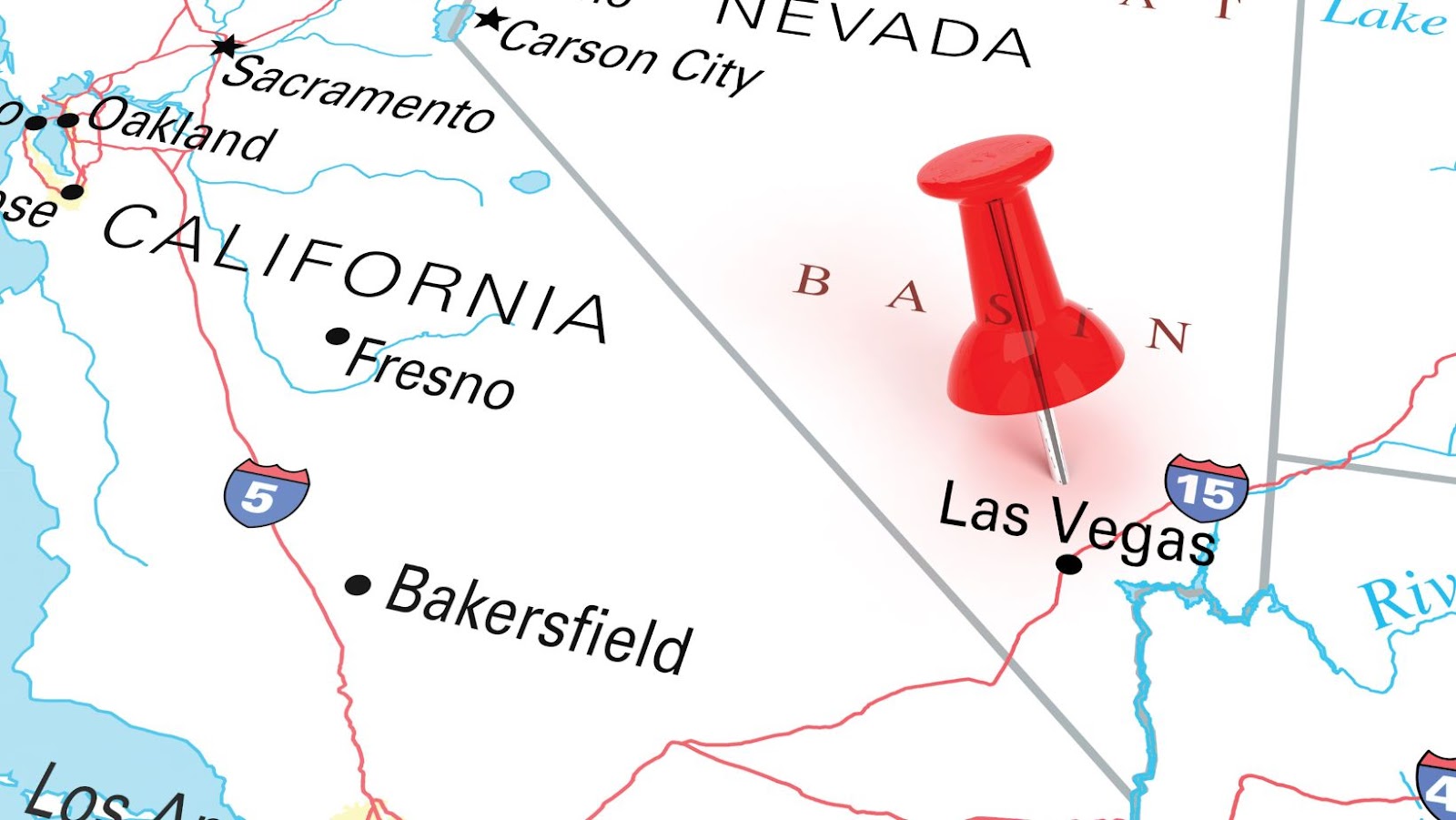Introduction
Las Vegas is the most populous city in the state of Nevada, United States, and it is known as the entertainment capital of the world. Located in the Mojave Desert and close to the border with California, Las Vegas is a popular tourist destination. Let’s take a closer look at the exact location of Las Vegas, Nevada and discuss how far it is from other places.
- Las Vegas is located in the Mojave Desert.
- Las Vegas is close to the California border.
- Las Vegas is a popular tourist destination.
The exact location of Las Vegas, Nevada can be determined by looking at a map. We can also calculate how far it is from other places. Here is a list of the distances from Las Vegas to other cities:
- Los Angeles, California: 267 miles
- Phoenix, Arizona: 279 miles
- San Diego, California: 274 miles
- Salt Lake City, Utah: 393 miles
Las Vegas, Nevada – Overview
Located in the Mojave Desert of Southern Nevada, Las Vegas is the largest city in the state and home to more than 641,000 people. This vibrant city, fondly known as Sin City, is known for its entertainment scene which includes dozens of casinos, live shows, and year-round events.
In addition to being a popular destination for tourists from around the world, Las Vegas also serves as an important economic center for Nevada. It is home to a diverse range of industries that include tourism, gaming, entertainment production, food service, retail sales and hospitality. The city also offers lots of attractions that are perfect for families looking for fun things to do.
Las Vegas is located less than two hours’ drive from some of Nevada’s most gorgeous national parks should you be looking to explore some breathtaking landscapes on your down time. In town there are thousands of restaurants offering all types of cuisines plus countless nightclubs where you can dance the night away after trying your luck on one or two slot machines or table games!
- Entertainment Scene: Dozens of casinos, live shows, and year-round events.
- Industries: Tourism, gaming, entertainment production, food service, retail sales and hospitality.
- Attractions: Perfect for families looking for fun things to do.
- National Parks: Gorgeous national parks just two hours’ drive away.
- Restaurants: Thousands of restaurants offering all types of cuisines.
- Nightclubs: Countless nightclubs where you can dance the night away.

Location of Las Vegas
Las Vegas, Nevada is situated in the southern region of the United States, in the Mojave Desert. The city is 360 miles south of Salt Lake City, Utah, 320 miles north of Tucson, Arizona and 292 miles south of Reno, Nevada. Las Vegas is the entertainment capital of the world with a population of over 600,000. Las Vegas is known for its iconic strip which is lined with hotels, casinos, restaurants and nightclubs.
Distance From Major Cities
Las Vegas, Nevada is a popular tourist destination and located in the heart of one of the most populous regions of the United States. This desert city is nestled in a valley located within Clark County, Nevada. It is bordered to the east by Henderson and North Las Vegas and to the south by Jean. Las Vegas has an estimated population of over 600,000 people as of 2016 and has been ranked one of the fastest growing cities in America.
Las Vegas is 425 miles south of Salt Lake City, Utah, 450 miles north-west of Phoenix, Arizona, 532 miles south-west of Denver, Colorado and 290 miles north-east of Los Angeles, California. It is at approximately 1150 feet above sea level in Clark County’s Mojave Desert with many nearby Mountains offering a scenic view from any angle including:
- Red Rock Canyon at 9999 feet elevation
- Mt Charleston just outside city limits at 11700 feet elevation
Distance From Major Airports
Las Vegas is located in the southern Nevada desert and is one of the most popular vacation destinations in the United States. The city is situated roughly four hours away from two of the largest airports in the western United States – McCarran International Airport (LAS) and Los Angeles International Airport (LAX).
McCarran International Airport (LAS)
The airport serves more than 60 million passengers each year, making it one of the busiest airports in the world. From Las Vegas, it’s a short 4 hour drive to LAS along Interstate 15, offering easy access for those visiting Las Vegas from other parts of California or Nevada.
Los Angeles International Airport (LAX)
Los Angeles International Airport is located about 130 miles south from Las Vegas, making it just over a 3 hour drive by car. While LAX does not offer direct flights to Las Vegas, there are many nonstop and connecting flights available for those looking to make a quick 1-2 hour trip. There are also several shuttles and buses operating between both cities:
- Shuttle 1
- Shuttle 2
- Bus 1
- Bus 2
Multiple times throughout the day.

Geographic Coordinates
Las Vegas is located in Clark County, Nevada. It covers an area of approximately 130.3 square miles and has a population of 641,676 people as of 2019. Las Vegas is situated in the Mojave Desert at an elevation of 2,186 feet (666 meters). The city’s geographic coordinates are 36° 10′ N and 115° 8′ W, making it the westernmost city in the continental United States. Nearby cities include Henderson to the east, Jean to the south and Boulder City to the southeast.
The area was originally settled by miners who referred to it simply as “Valley” until railroad companies arrived in 1904 and changed its name to Las Vegas -Spanish for ‘the meadows’. The meadows along what’s now known as Las Vegas Boulevard became a bustling oasis with gambling halls, salons and shops built up around natural springs that supplied water like quiet streetside oases today. By 1931 gambling had become legal within the state of Nevada and Las Vegas was well established during this time as its premier tourist destination for those seeking entertainment that could only be found there.
Climate of Las Vegas
Located in the Mojave Desert of the southwestern United States, Las Vegas, Nevada is known for its sunny and warm climate. With an average of 310 sunny days per year, it’s no wonder why the city is a popular destination for vacationers.
Winters in Las Vegas are mild with temperatures ranging from 40-70 degrees Fahrenheit, and summers are hot and dry with temperatures reaching up to 100 degrees Fahrenheit. Explore further to learn about the climate of Las Vegas:
- Average temperature by month
- Average rainfall
- Weather events
- Average humidity
Average Temperatures
The city of Las Vegas is located in the Mojave Desert. As such, it experiences hot summers and very mild winters. Average temperatures range from a low of 40°F (4.5°C) in the winter months to an average high of 107°F (41°C) during summer months. Winter months bring cold nights and warm afternoons, with daytime temperatures often reaching 70–80°F (21.1–26.7°C). With minimal precipitation during this season, deluge rains can sometimes occur and result in flooding along tributaries from Boulder City to Lake Mead.
Summer in Las Vegas brings scorching temperatures that often reach triple digits and bring with them hot, dry desert winds from the southwest throughout the day and calm evenings as temperatures drop into the 80s at night. June is full of sunny skies and lush vegetation due to ample monsoon rain earlier in the month typically lasting into mid-July before officially shutting off with drastic temperature increases taking over for nearly 4 months until fall arrives each September or October depending on that year’s weather patterns.
Las Vegas experiences an average yearly precipitation of approximately 4 inches a year which helps to keep desert dust levels down allowing for much more comfortable outdoor activities during this time compared to other desert cities like Phoenix or Tucson which experience much less rainfall than LV does year round.

Average Rainfall
Las Vegas is located in a desert climate characterized by hot summers, mild winters and very low annual rainfall. The city receives an average of 4.19 inches (106 millimeters) of rain per year and the majority of this precipitation falls in the winter months, with February having the most rainfall with 0.53 inches (13.4 millimeters).
- Summer months: Rainfall is rare — as little as two days out of the entire summer season can bring showers and thunderstorms that can drop .004 inches to .32 inches (10mm) at a time.
- Winter months: Bring more frequent rainfalls, however snow is usually absent from this desert climate — over a period of 140 years, Las Vegas has had only 20 snow days.
Conclusion
Las Vegas, Nevada is located in the Mojave Desert region of the northwestern United States. It sits in Clark County approximately 540 feet above sea level, and it has a population of nearly 600 thousand people. The city is known as the entertainment capital of the world, having some of the most luxurious hotels and casinos, as well as many attractions for tourists who come from all around the world. Las Vegas draws more than 35 million people each year, making it one of the most visited cities in North America.
The city is divided into seven main regions:
- North Las Vegas
- West Las Vegas
- East Las Vegas
- Downtown Las Vegas (The Strip)
- Summerlin South
- Enterprise
- Paradise
Popular neighborhoods include Boulder City, Henderson and North West Valley. In addition to its tourist attractions and vibrant nightlife, visitors will find beautiful desert landscapes nearby like Lake Mead National Recreation Area and Red Rock Canyon National Conservation Area. There are also a number of professional sports teams based in Las Vegas that offer an exciting way to spend an afternoon or evening cheering on your favorite team!
